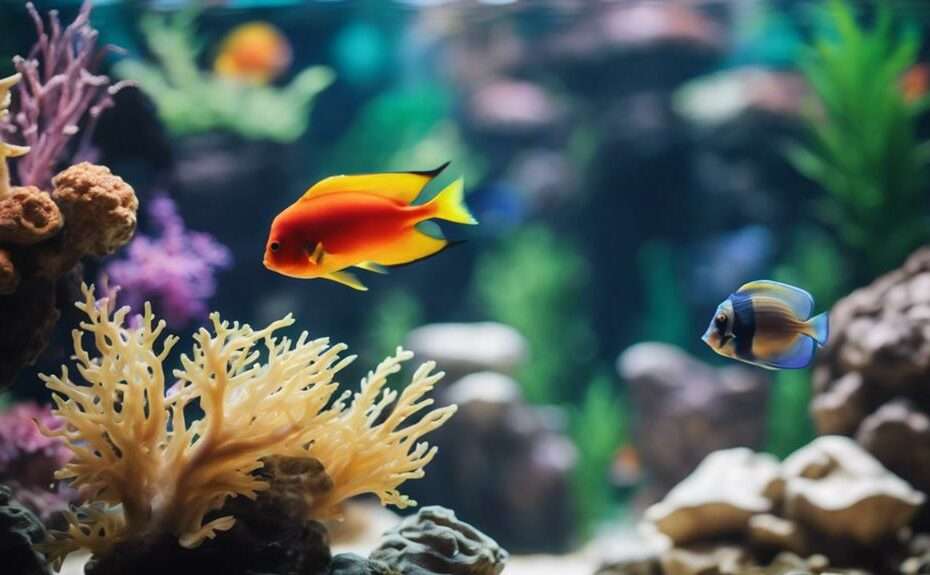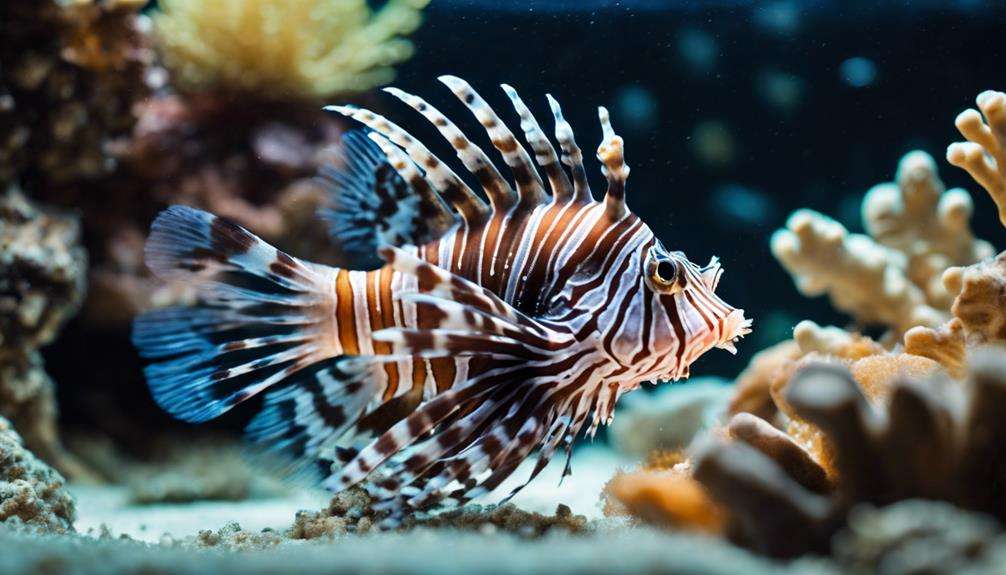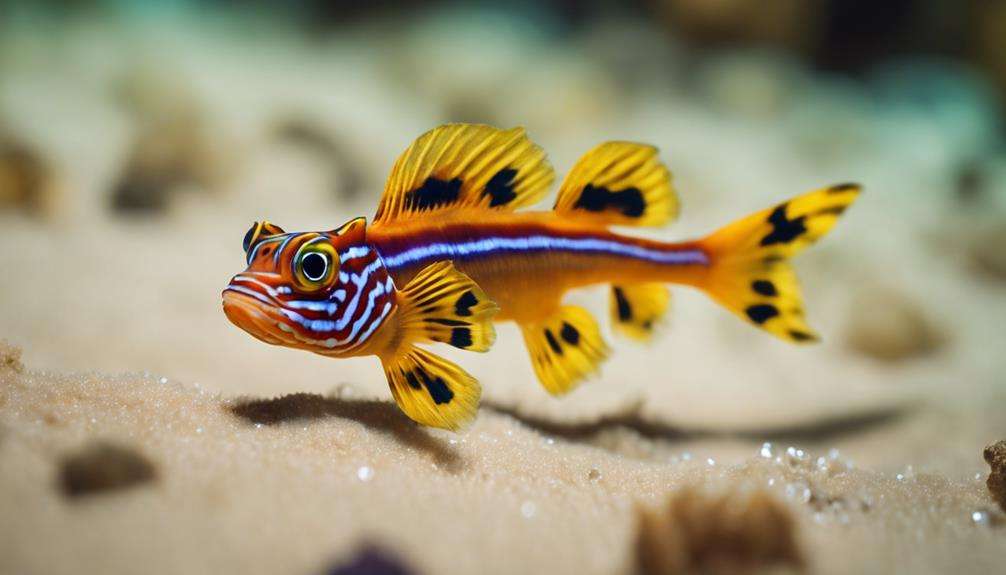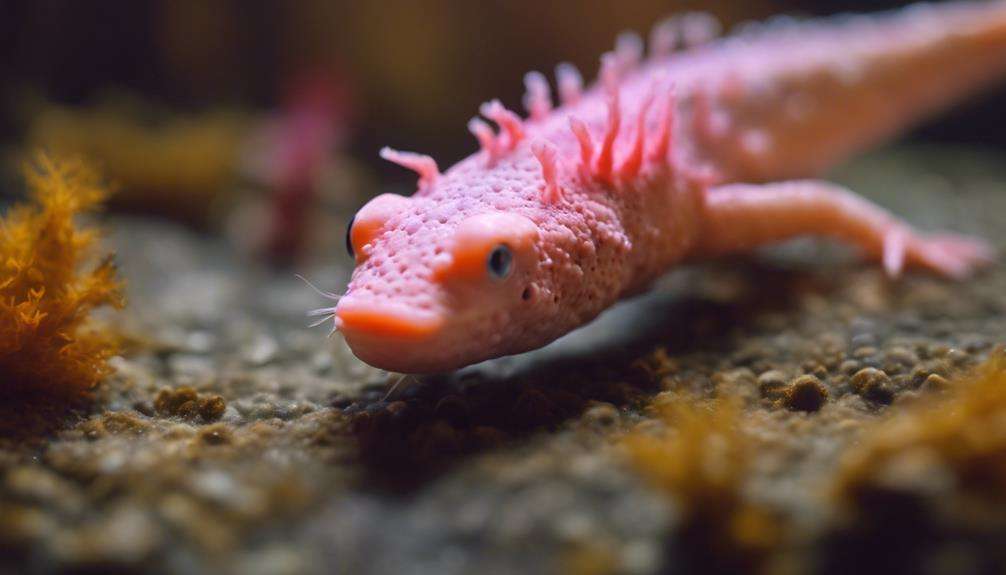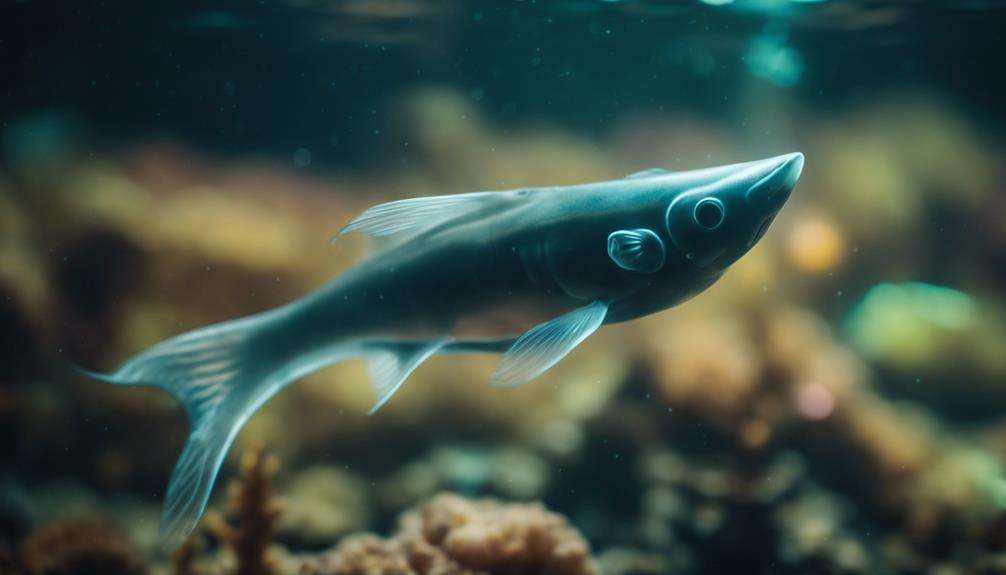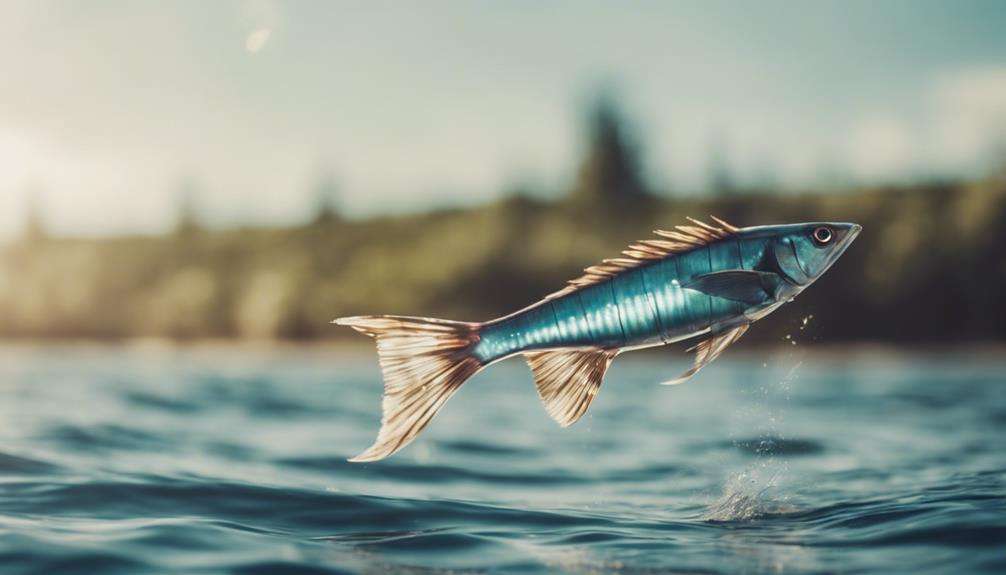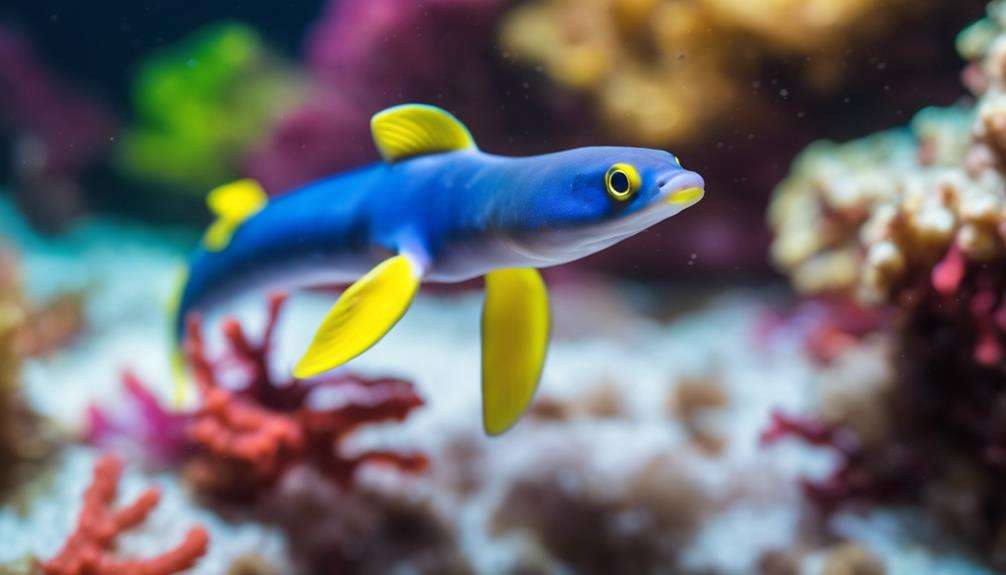When it comes to creating the perfect habitat for your Batfish, ensuring optimal tank conditions is key. From the size of your tank to the water quality parameters and suitable tank mates, there are seven essential tips to consider.
But, before we dive into the specifics, let's explore how these factors can impact the overall well-being and vibrancy of your aquatic companions.
Key Takeaways
- Provide a spacious tank with minimum 100 gallons and ample horizontal swimming space.
- Maintain stable water quality parameters within specific ranges for health and well-being.
- Create a habitat with low to moderate lighting, shaded areas, and natural hiding spots.
- Offer a varied diet, feed multiple times a day, and monitor feeding to prevent overeating.
Tank Size and Shape
When setting up your aquarium for Pinnatus batfish, ensure a minimum tank size of 100 gallons to accommodate their size and swimming behavior effectively. These batfish require ample space to move around due to their elongated bodies and graceful swimming style.
A rectangular tank shape is ideal as it provides the necessary horizontal swimming space for the batfish. The tank should have a minimum length of 4 feet to allow the batfish to swim freely without feeling cramped. It's crucial to avoid tall tanks, as Pinnatus batfish prefer swimming horizontally rather than vertically.
Water Quality Parameters
What water quality parameters are crucial for maintaining the optimal health of Batfish? Proper water conditions are essential for the well-being of your Platax teira. To ensure your Batfish thrives in your tank, here are the key water quality parameters you need to monitor:
- Specific Gravity: Maintain levels between 1.020-1.025 to mimic their natural marine habitat accurately.
- pH Levels: Keep pH between 8.1-8.4 to create a suitable environment for your Batfish to thrive.
- Alkalinity: Monitor alkalinity (dKH) within the range of 8-12 to support the physiological functions of your Batfish.
- Water Temperature: Keep the water temperature stable within the range of 72-78°F (22-26°C) to ensure the comfort and health of your Batfish.
Remember to regularly test and maintain low levels of ammonia, nitrites, and nitrates in your tank to provide a healthy and thriving environment for your Batfish. By carefully monitoring these water quality parameters, you can create an optimal living space for your beloved Batfish.
Lighting Requirements
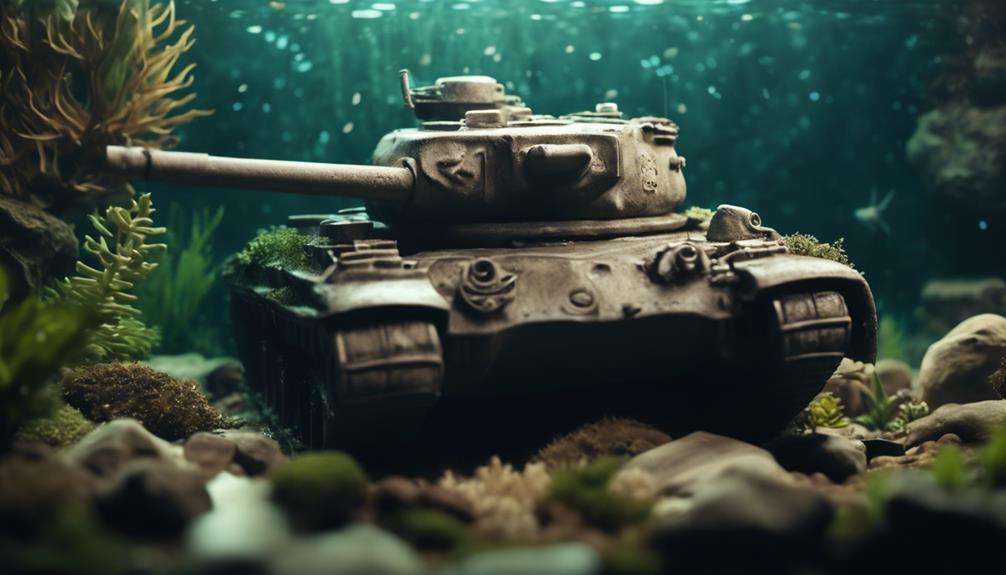
You should consider the ideal light intensity, proper light spectrum, and lighting duration limits for your Pinnatus Batfish.
Adjust the lighting intensity to low to moderate levels to prevent stress.
Ensure the spectrum of your lights mimics the natural lighting conditions of their native habitat for their well-being.
Ideal Light Intensity
To ensure the well-being of Pinnatus Batfish in your aquarium, it's crucial to provide moderate to low light intensity, as excessive lighting can lead to stress and health issues for these fish. Here are some tips to help you achieve the ideal light conditions for your Batfish:
- Shaded Areas: Create shaded spots in the tank where the Batfish can retreat from bright light.
- Dimmable LED Lights: Use dimmable LED lights to adjust the light intensity according to the needs of the Batfish.
- Natural Habitat: Mimic their natural environment by providing subdued lighting to make them feel more comfortable.
- Balance: Ensure the light intensity is balanced with other tank conditions to promote the overall well-being of your Pinnatus Batfish.
Proper Light Spectrum
When considering the proper light spectrum for Pinnatus Batfish in your aquarium, it's essential to focus on replicating the low to moderate lighting conditions of their natural deep-water habitat to promote their well-being and reduce stress.
Batfish, with their unique pectoral fins and deep-water origin, thrive under dimmer lighting that mimics the subdued illumination found at greater depths. Avoiding intense lighting sources is crucial as excessive brightness can lead to discomfort and stress, impacting the health of these sensitive creatures.
LED lights, particularly those with adjustable intensity settings, offer an ideal solution for creating the appropriate light spectrum for your batfish tank. By recreating the natural light spectrum of dawn and dusk, you can support the natural behaviors and overall health of your Pinnatus Batfish in captivity.
Lighting Duration Limits
For optimal tank conditions for Pinnatus Batfish, it's crucial to establish appropriate limits on lighting duration to ensure their well-being and prevent stress-related issues. When considering lighting duration limits for your batfish, keep the following key points in mind:
- Moderate to Low Lighting: Provide moderate to low lighting in the tank to replicate the batfish's natural habitat.
- Limit Duration: Restrict the lighting period to 8-10 hours per day to avoid stress and prevent algae overgrowth.
- Prevent Disruption: Excessive lighting can disrupt the batfish's natural behavior and lead to algae blooms.
- Adjustable LED Lights: Utilize LED lights with adjustable settings to manage the intensity and duration of light exposure effectively.
Filtration System Setup
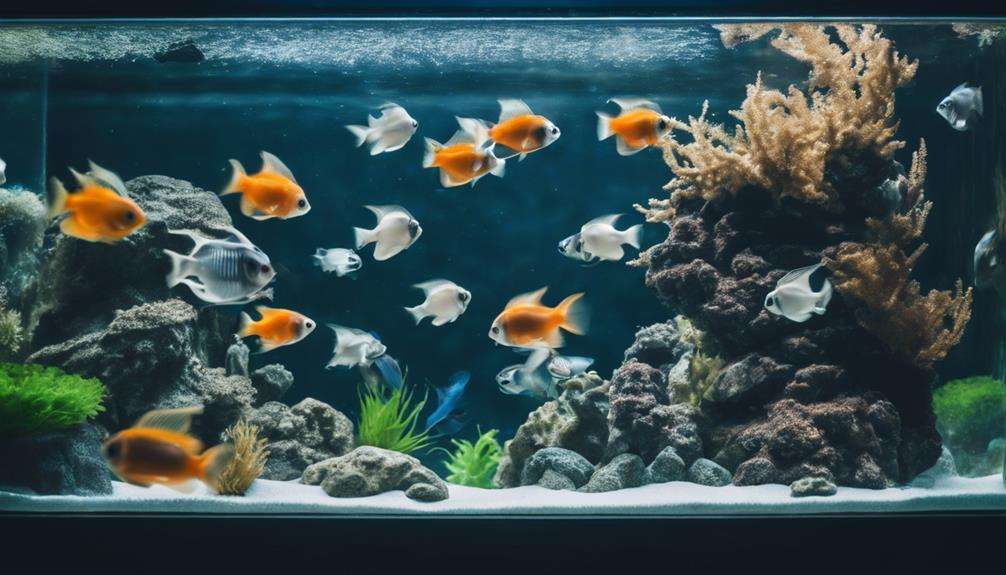
Consider incorporating a protein skimmer and sump in your filtration system setup to effectively remove organic compounds and maintain water clarity for your Batfish in a 200-gallon tank.
For saltwater fish like Batfish, a high-quality filtration system is essential to ensure optimal water quality. This system should consist of mechanical, biological, and chemical filtration components to efficiently eliminate waste and support a healthy aquatic environment.
Protein skimmers play a crucial role in removing organic compounds, such as proteins and other organic molecules, by creating foam that traps them before they decompose and affect water quality. Sumps, on the other hand, provide additional water volume and space for equipment like heaters and protein skimmers, enhancing overall filtration capacity.
To maintain peak performance, it's vital to regularly clean and maintain the filtration media, preventing the accumulation of harmful substances in the tank. Monitoring key water parameters like ammonia, nitrites, and nitrates is also crucial to ensure that the filtration system is effectively processing waste and sustaining a stable habitat for your Batfish.
Substrate and Decoration Options
To provide an optimal environment for your Batfish in a 200-gallon tank, selecting the right substrate and decorations is crucial for mimicking their natural habitat and ensuring their well-being. Here are some essential tips to consider:
- Substrate Options: Pinnatus Batfish prefer a sandy substrate that resembles their natural environment. A fine sand substrate will allow them to exhibit their natural foraging behaviors and feel more at home in the tank.
- Decoration Options: Live rock formations are beneficial as they provide hiding spots and grazing areas for Batfish. These rocks can also help in creating territories within the tank, reducing aggression among tank mates.
- Decoration Options: Incorporating artificial plants or corals not only enhances the aesthetic appeal of the tank but also provides enrichment for the Batfish. These decorations can serve as shelter and exploration areas for your fish.
- Decoration Options: Avoid using sharp decorations that may harm the delicate fins of the Batfish. Opt for smooth, rounded decorations to ensure the safety of your fish as they navigate their environment.
Temperature and Water Flow
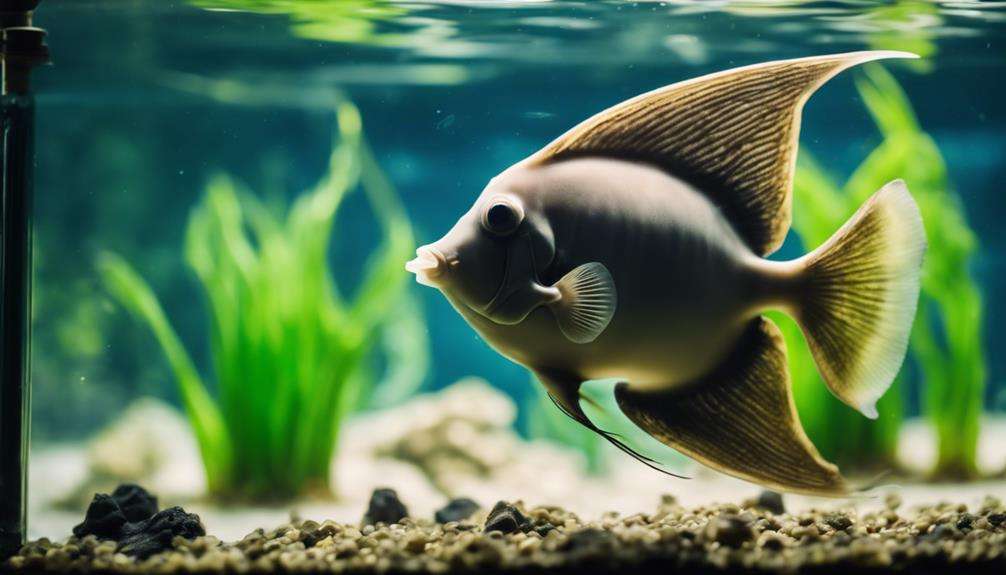
Maintain the Pinnatus Batfish tank water temperature within the range of 72-78°F (22-26°C) to support their optimal health and well-being. Consistency in water temperature is crucial for the well-being of these fish.
Adequate water flow is also essential in their tank setup. It helps mimic their natural habitat and ensures proper oxygen levels in the water. When setting up the water flow, it's important to strike a balance. Strong currents should be avoided as they can stress or tire out the batfish.
Consider using wavemakers or powerheads to create gentle water movement. Monitoring and adjusting the water flow is key to creating an environment where the batfish can swim comfortably and exhibit their natural behaviors.
Tank Mates and Compatibility
Wondering which tank mates are suitable for your peaceful and social Batfish to ensure a harmonious aquatic environment? When selecting companions for your Batfish, it's crucial to consider their peaceful nature and social behavior. Here are some ideal tank mates to keep your Batfish happy and stress-free:
- Boxfish: These gentle and slow-moving fish are compatible tank mates for Batfish, creating a tranquil environment.
- Clownfish: Known for their playful nature, Clownfish can coexist harmoniously with Batfish, enhancing the social dynamics in the tank.
- Gobies: Gobies are peaceful bottom-dwellers that can complement the Batfish's swimming patterns, adding diversity to the tank.
- Tangs and Butterflyfish: These colorful and active swimmers are great companions for Batfish, as they share similar environmental preferences and behaviors.
Frequently Asked Questions
What Are the Best Water Conditions for a Fish Tank?
Maintain optimal tank conditions by keeping the water temperature between 72-78°F. Ensure pH levels range from 8.1 to 8.4. Choose a suitable tank size and effective filtration system. These factors are crucial for creating a healthy environment for your fish.
Are Batfish Hard to Keep?
Keeping Batfish can be challenging due to their specific care needs and susceptibility to diseases. Acclimating them to aquarium life, especially if wild-caught, requires patience. Experienced aquarists with large tanks are better suited for these unique fish.
How Do I Keep My Fish Tank Healthy?
To keep your fish tank healthy, monitor water quality and temperature closely. Regular maintenance, including water changes and filtration upkeep, is crucial. Maintaining optimal conditions ensures a thriving aquatic environment for your fish to flourish.
What Do Catfish Like in Their Tank?
In their tank, catfish like environments with ample hiding spots such as caves and plants. They prefer soft, sandy substrate for their bottom-dwelling behavior. Offering a varied diet with sinking pellets and algae wafers is crucial for their health.
Conclusion
In conclusion, ensuring optimal tank conditions for Batfish is crucial for their well-being and longevity.
While some may be concerned about the maintenance required for a larger tank, the benefits of providing a spacious environment with stable water parameters far outweigh the effort.
By following the 7 essential tips outlined in this article, you can create a thriving habitat for your Batfish and enjoy their peaceful presence in your aquarium.
